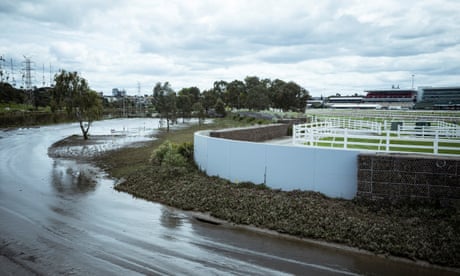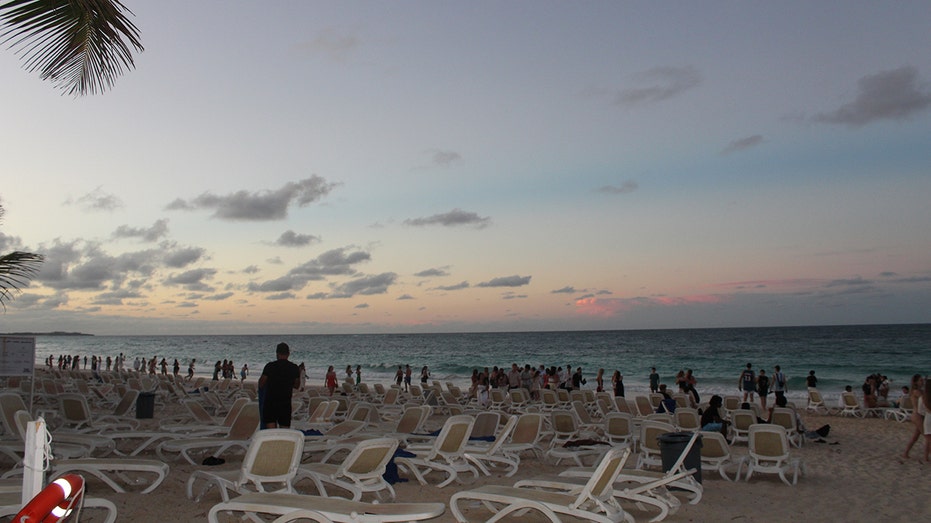- by foxnews
- 12 Mar 2025
Racing Victoria chief says Flemington racetrack wall had ‘unintended’ flood consequences
Racing Victoria chief says Flemington racetrack wall had ‘unintended’ flood consequences
- by theguardian
- 16 Oct 2022
- in news

The flood wall built to protect Flemington racetrack from inundation has had "unintended consequences for neighbouring residents", the chief executive of Racing Victoria has conceded, as homes surrounding the track began the clean-up from devastating floods.
Andrew Jones told Channel Nine the flooding of the suburbs of Maribyrnong and Kensington was "a difficult situation", and expressed sympathy for those affected.
"The VRC took steps to flood-protect its property 15 years ago, which it's entitled to do, [and] that's obviously had unintended consequences for neighbouring residents," he said. "I know that bit of Kensington quite well, I walk through there every morning on the way to work."
Residents in neighbouring suburbs say the Victorian Racing Club's decision to build a flood wall along the side of the track by the Maribyrnong River pushed flood waters away from the track and into their homes.
Jones said: "Obviously there was no intention of the VRC to cause harm. They tried to protect the spring carnival and the Melbourne Cup carnival, which is a massively important part of Victorian life and the Victorian economy, so I think this is an unintended consequence."
Local historian and long-term Footscray resident Liz Crash said the Maribyrnong River rarely broke its banks, but when it did, historically, "you got a very shallow flood for miles around".
She said infill housing developments, approved by state governments and encroaching further and further on to the flood plain, had made that flooding more damaging.
Crash said when the river broke its banks this week Footscray Park, on the western side of the river, acted as the floodplain had in previous floods to disperse and "soak up" the water.
But on the other side of the river, the flooding of roads and homes was far more significant.
"The flooding in the area around the Princes Highway, right next to the wall, that was completely flooded and a big chunk of that would have been soaked up by the floodplain."
Crash said there had been serious concerns raised about the wall when it was first proposed in 2004, but councils and residents were given little information or opportunity to object.
"If this flooding was unexpected, why did they bother building the flood wall? Was there information that, with the impacts of climate change, the one in every 100 years flood was going to be every 20 years, every five years, an annual event?"
Stan Graddzki sandbagged his Maribyrnong home ahead of the forecast flood peak, but his efforts to keep the rising water out were swiftly overwhelmed.
He said he didn't believe the racetrack wall contributed to the flood.
"When all that water comes down that river at that speed, there's nothing that can stop it," he said. "I don't think that made a difference. I don't think anyone's to blame for what happened, except for what happening to the planet at the moment."
In 2004, the three councils that abut the Flemington track - Melbourne City, Maribyrnong and Moonee Valley - opposed the wall's development, warning the state government that building the flood wall would exacerbate flooding of homes near the racetrack.
In approving the plan, the then state planning minister, Mary Delahunty, said: "The flood protection works and racetrack upgrade will ensure that major horse racing events at Flemington, such as the Cup or the Victoria Derby, cannot be affected by major flooding of the Maribyrnong River.
"Melbourne Water's modelling confirms that, provided the compensatory works are in place, there is no increase in risks to people and property in the river valley."
The deputy leader of the Victorian Greens, Ellen Sandell, said the profits of the gambling industry were being put above the welfare of people and their homes.
"Yesterday, areas of Kensington were under metres of water while the Flemington Racecourse was kept largely dry by a flood wall, pushed through by a Labor government at the expense of the community and against the wishes of council."
Sandell said that, when the flood wall was first proposed, councils argued that if it was built, flood waters would not be able to dissipate over the broad expanse of the racetrack, and would, instead, be pushed towards homes.
"This is exactly what we've seen. Yesterday we saw people along the Maribyrnong River lose everything. We've seen people lose cars, lose homes and lose all their possessions.
"Yet the Labor government's priority was to protect the profits of the gambling and racing industry.
"Once these flood waters subside, Racing Victoria and every associated gambling entity about to bank millions at the Spring Racing Carnival better be ready to stump up the cash to help with the flood clean-up effort."
On Friday, as water levels peaked, former VRC chief executive and now the chairman of Harness Racing Victoria, Dale Monteith, posted "then and now" pictures of previous flooding at Flemington track online, defending the decision to build the flood wall.
"Took five years with process and build," he posted. "Pretty happy that we have left a legacy for [the] future of Flemington. Was always going to happen but ignored previously."
Monteith's tweet has since been deleted.
Tim Wiebusch, the chief officer operations of the State Emergency Service, said whether the Flemington racecourse flood wall had contributed to flooding elsewhere was a question for Melbourne Water.
"The levee that exists in Maribyrnong is on both sides and it's also around the racecourse," he said. "Whether that has contributed to flooding is something probably that we would need to refer to Melbourne Water."
The Guardian has approached Melbourne Water for comment.
- by foxnews
- descember 09, 2016
Daring airport trend has travelers arriving at gate 15 minutes before takeoff
Flight passengers are participating in the new viral trend, "airport theory," with flyers arriving at their gates 15 minutes before their flights depart. A travel expert weighs in.
read more


